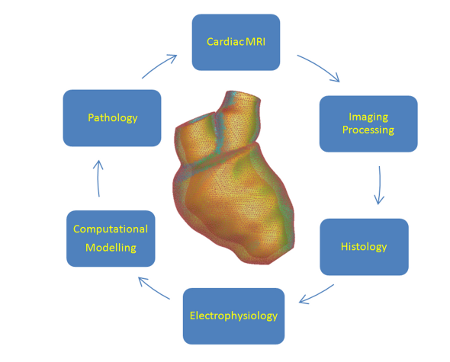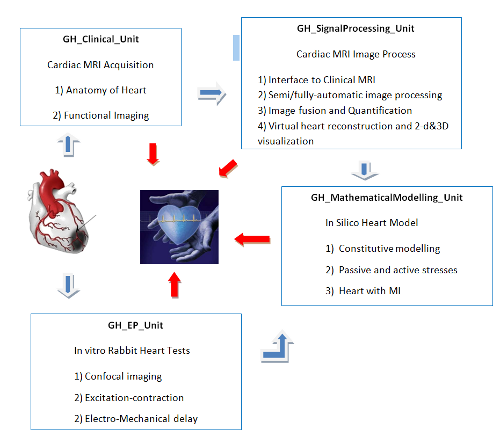Overview
An overview of the GlasgowHeart (GH) system is shown in the figure below:

The GlasgowHeart consortium comprises the following sub-units:

(1) GH_Clinical_Unit;
The BHF Glasgow Cardiovascular Research Centre hosts a new wide-bore clinical grade 3.0 Tesla MRI scanner (Verio MAGNETOM Siemens Healthcare). The MRI Facility is dedicated to cardiovascular research and is a Joint University NHS partnership with close links to other hospitals in Glasgow. In addition, the Principal Investigators (Drs Berry, Foster and Walters) lead a national cardiovascular imaging research network in Scotland with the Universities of Aberdeen, Dundee and Edinburgh all of whom have new 3.0 T MRI scanners.
Prof. Colin Berry has MRI research collaboration agreements with Siemens Healthcare and also with physicists at the US National Institutes of Health,Bethesda,MD. These agreements mean we have a leading role in the clinical development of new MRI methods for heart disease. Our pivotal and key strength is access to large patient populations and our ability to link our imaging results with health outcome events through patient follow-up.
(2) GH_SignalProcessing_Unit
The Department of Electronic and Electrical Engineering was rated 3rd in theUK from the Research Assessment Exercise in 2008 for the number of active researchers and research income. The Centre for Excellence in Signal and Image Processing (CeSIP) has a world class reputation for innovative research on new Algorithms, Architectures and Applications. Within CeSIP a platform is provided for the development of tools, techniques and systems to be used for the acquisition, analysis and extraction of information. Interdisciplinary research collaboration ranges from concept development through to applications driven research in key industrial sectors. Professor Soraghan is head of the signal processing algorithms and architectures research group within CeSIP leading research programmes in biomedical, radar&remote sensing and multimedia signal and image processing. He has supervised 36 PhD students to graduation and has published over 270 technical papers.
Prof Soraghan has collaborated with the Cardiology Dept, Western Infirmary, Universityof Glasgowand other main hospitals in Glasgowfor over 20 years. His work has lead to a fully automated echocardiographical data processing system for 2-d and 3-D echocardiographical sequences. In collaboration with Co-PI, Dr Colin Berry, his GlasgowHeart algorithms are capable of automatically processing a set of MRI slices for 3D cardiac visualisation and oedema quantification. His collaboration with ENT surgeon Mr Brian O’Reilly, Southern General hospital has delivered a new objective measure for measure the degree of facial palsy called the Glasgow Facial Palsy Scale (GFPS) www.gfps.org.uk .
As Texas Instruments Chair in Signal Processing within theUniversityofStrathclyde, Professor Soraghan exploits TI technologies within his research and teaching activities.
(3) GH_MathematicalModelling_Unit
We use novel methods with magnetic resonance imaging (MRI) and mathematics to construct 3D multi-scale modelling of heart, with intention to explore acute myocardial infarction (MI) in experimental animals and humans. The cardiac MRI methods provide information on structure, function and pathology in a single scan. The mathematical methods take the MRI data to recreate geometric models of the heart, include fibre structure, and making use of structure-based constitutive models and bi-domain based active contraction. The parameters of the constitutive models will be identified using an inverse approach from the dynamic strain field measured by the 3D displacement encoding with stimulated-echos (DENSE) MRI from human subjects at the Glasgow BHF centre. Since MRI is safe and can be repeated, heart models can be developed serially and so evolve in response to changes in the heart post-MI. For the mechanical modelling of the heart, we use the finite-element immersed boundary method - IBAMR, modelling the 3D finite strain with fluid-structure interaction. IBAMR combines the strength of the conventional IB methods and the finite element methods, and enables both the fluid-structure interaction, and the complicated nonlinear finite strain solid mechanics to be modelled accurately and effectively.
Prof. Luo is currently the PI for two EPSRC projects. She is a Fellow of the Institution of Mechanical Engineers, and on the editorial boards of the International Journal of Computer Mathematics-Section B and the International Journal for Numerical Methods in Biomedical Engineering, Journal of Applied Mathematics, and a member of the EPSRC college. She received a Global Research Award from the Royal Academy of Engineering in 2007. In addition to collaborating with her medical colleagues, she also collaobrates with top mathematicians and engineers, including Prof Ogden, FRS, Prof. Hill, Dr. Roper, Dr. Semitev (University of Glasgow); Prof. Holzapfel (Graz University of Technology); Prof. Griffith (New York University); and Prof. Wang (Xi'an Jiaotong University).
4) GH_EP_Unit
5) GH_Histology_Unit

